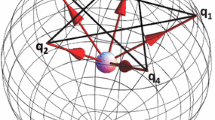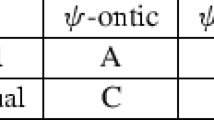Abstract
There exist several phenomena breaking the classical probability laws. The systems related to such phenomena are context-dependent, so that they are adaptive to other systems. In this paper, we present a new mathematical formalism to compute the joint probability distribution for two event-systems by using concepts of the adaptive dynamics and quantum information theory, e.g., quantum channels and liftings. In physics the basic example of the context-dependent phenomena is the famous double-slit experiment. Recently similar examples have been found in biological and psychological sciences. Our approach is an extension of traditional quantum probability theory, and it is general enough to describe aforementioned contextual phenomena outside of quantum physics.
Similar content being viewed by others
Notes
In this paper we proceed pragmatically. We do not discuss arguments for and against hidden variables. We want just proceed mathematically. In the literature on quantum foundations it is generally claimed that Kolmogorov description of the double-slit experiment is impossible, cf., however, [19].
Elaboration of such generalized quantum(-like) dynamics is not based on just a rather common wish to consider so general situation as possible. Already the simplest examples from biology, see Sect. 4, demonstrate that for such biological systems the dynamical state change cannot be described in the conventional quantum framework. Elaboration of such a new mathematical apparatus and its application to biology differs this paper from our previous publications [7, 8] in which the standard theory of open dynamical systems was in use. By the same reason we presented AD-theory in the framework of C ⋆-algebras (and not simply complex Hilbert space): in general there are no reasons to expect that the probabilistic structure of all possible biological phenomena can be embedded into complex Hilbert space model of probability.
We point out that by using liftings we operate with entangled quantum states. By the conventional interpretation of quantum mechanics the corresponding probabilistic structure cannot be represented classically, in a Kolmogorov space. However, we again remark that inter-relation between classical and quantum probabilistic descriptions is still actively debated.
References
Accardi, L.: Urne e Camaleonti: Dialogo Sulla Realta, le Leggi del Caso e la Teoria Quantistica. Il Saggiatore, Perugia (1997). English edition: World Scientific (2002); Japanese edition: Makino (2002), Russian edition, Regular and Chaotic dynamics (2002)
Accardi, L., Ohya, M.: Compound channels, transition expectations, and liftings. Appl. Math. Optim. 39, 33–59 (1999)
Accardi, L., Ohya, M.: A stochastic limit approach to the SAT problem. Open Syst. Inf. Dyn. 11, 1–16 (2004)
Accardi, L., Khrennikov, A., Ohya, M.: The problem of quantum-like representation in economy, cognitive science, and genetics. In: Accardi, L., Freudenberg, W., Ohya, M. (eds.) Quantum Bio-Informatics II: from Quantum Information to Bio-Informatics, pp. 1–8. WSP, Singapore (2008)
Accardi, L., Khrennikov, A., Ohya, M.: Quantum Markov model for data from Shafir–Tversky experiments in cognitive psychology. Open Syst. Inf. Dyn. 16, 371–385 (2009)
Allahverdyan, A.E., Balian, R., Nieuwenhuizen, Th.M.: The quantum measurement process in an exactly solvable model. In: Foundations of Probability and Physics-3. American Institute of Physics, Ser. Conference Proceedings, vol. 750, pp. 16–24. Melville, New York (2005)
Asano, M., Ohya, M., Khrennikov, A.: Quantum-like model for decision making process in two players game. Found. Phys. 41(3), 538–548 (2010)
Asano, M., Ohya, M., Tanaka, Y., Khrennikov, A., Basieva, I.: On application of Gorini–Kossakowski–Sudarshan–Lindblad equation in cognitive psychology. Open Syst. Inf. Dyn. 18(1), 55–69 (2011)
Asano, M., Ohya, M., Tanaka, Y., Khrennikov, A., Basieva, I.: Quantum-like representation of Bayesian updating. In: Proceedings of the International Conference on Advances in Quantum Theory. American Institute of Physics, vol. 1327, pp. 57–62 (2011)
Basieva, I., Khrennikov, A., Ohya, M., Yamato, I.: Quantum-like interference effect in gene expression: glucose-lactose destructive interference. Syst. Synth. Biol. (2011). doi:10.1007/s11693-011-9081-8
Busemeyer, J.R., Matthews, M., Wang, Z.: A quantum information processing explanation of disjunction effects. In: Sun, R., Myake, N. (eds.) The 29th Annual Conference of the Cognitive Science Society and the 5th International Conference of Cognitive Science, pp. 131–135. Erlbaum, Mahwah (2006)
Busemeyer, J.B., Wang, Z., Townsend, J.T.: Quantum dynamics of human decision making. J. Math. Psychol. 50, 220–241 (2006)
Busemeyer, J.R., Santuy, E., Lambert-Mogiliansky, A.: Comparison of Markov and quantum models of decision making. In: Bruza, P., Lawless, W., van Rijsbergen, K., Sofge, D.A., Coeke, B., Clark, S. (eds.) Quantum Interaction: Proceedings of the Second Quantum Interaction Symposium, pp. 68–74. College Publications, London (2008)
Caves, C.M., Fuchs, Ch.A., Schack, R.: Quantum probabilities as Bayesian probabilities. Phys. Rev. A 65, 022305 (2002)
Cheon, T., Takahashi, T.: Interference and inequality in quantum decision theory. Phys. Lett. A 375, 100–104 (2010)
Cheon, T., Tsutsui, I.: Classical and quantum contents of solvable game theory on Hilbert space. Phys. Lett. A 348, 147–152 (2006)
Conte, E., Khrennikov, A., Todarello, O., Federici, A., Zbilut, J.P.: Mental states follow quantum mechanics during perception and cognition of ambiguous figures. Open Syst. Inf. Dyn. 16, 1–17 (2009)
D’ Ariano, G.M.: In: Operational Axioms for Quantum Mechanics. Foundations of Probability and Physics-3. American Institute of Physics, Ser. Conference Proceedings, vol. 889, pp. 79–105. Melville, New York (2007)
De Muynck, W.M.: Foundations of Quantum Mechanics, an Empiricists Approach. Kluwer Academic, Dordrecht (2002)
Fichtner, K.-H., Fichtner, L., Freudenberg, W., Ohya, M.: On a quantum model of the recognition process. In: QP-PQ: Quantum Prob. White Noise Analysis, vol. 21, pp. 64–84 (2008)
Fuchs, Ch.A., Schack, R.: A quantum-Bayesian route to quantum-state space. Found. Phys. 41, 345–356 (2011)
Garola, C., Sozzo, S.: The ESR model: a proposal for a noncontextual and local Hilbert space extensions of QM. Europhys. Lett. 86, 20009–20015 (2009)
Garola, C., Sozzo, S.: Generalized observables, Bell’s inequalities and mixtures in the ESR model. Found. Phys. 41, 424–449 (2011)
Inada, T., Kimata, K., Aiba, H.: Mechanism responsible for glucose-lactose diauxie in Escherichia coli challenge to the cAMP model. Genes Cells 1, 293–301 (1996)
Inoue, K., Ohya, M., Sato, K.: Application of chaos degree to some dynamical systems. Chaos Solitons Fractals 11, 1377–1385 (2000)
Inoue, K., Ohya, M., Volovich, I.V.: Semiclassical properties and chaos degree for the quantum baker’s map. J. Math. Phys. 43(1), 734 (2002)
Khrennikov, A.: Open Syst. Inf. Dyn. 11(3), 267–275 (2004)
Khrennikov, A.: Biosystems 84, 225–241 (2006)
Khrennikov, A.: Contextual Approach to Quantum Formalism (Fundamental Theories of Physics). Springer, Berlin (2009)
Khrennikov, A.: Ubiquitous Quantum Structure: from Psychology to Finance. Springer, Berlin (2010)
Khrennikov, A., Haven, E.: Quantum mechanics and violations of the sure-thing principle: the use of probability interference and other concepts. J. Math. Psychol. 53, 378–388 (2009)
Kossakowski, A., Ohya, M., Togawa, Y.: How can we observe and describe chaos? Open Syst. Inf. Dyn. 10(3), 221–233 (2003)
Ohya, M.: Note on quantum proability. Lett. Nuovo Cimento 38(11), 203–206 (1983)
Ohya, M.: On compound state and mutual information in quantum information theory. IEEE Trans. Inf. Theory 29, 770–777 (1983)
Ohya, M.: Some aspects of quantum information theory and their applications to irreversible processes. Rep. Math. Phys. 27, 19–47 (1989)
Ohya, M.: Complexities and their applications to characterization of chaos. Int. J. Theor. Phys. 37(1), 495–505 (1998)
Ohya, M.: Adaptive dynamics and its applications to chaos and NPC problem. In: QP-PQ: Quantum Probability and White Noise Analysis, Quantum Bio-Informatics 2007, vol. 21, pp. 181–216 (2007)
Ohya, M., Volovich, I.V.: New quantum algorithm for studying NP-complete problems. Rep. Math. Phys. 52(1), 25–33 (2003)
Ohya, M., Volovich, I.V.: Mathematical Foundations of Quantum Information and Computation and Its Applications to Nano- and Bio-Systems. Springer, Berlin (2011)
Plotnitsky, A.: Reading Bohr: Physics and Philosophy. Springer, Berlin (2006)
Plotnitsky, A.: Epistemology and Probability: Bohr, Heisenberg, Schrödinger, and the Nature of Quantum-Theoretical Thinking. Springer, Berlin (2009)
Plotnitsky, A.: On the reasonable and unreasonable effectiveness of mathematics in classical and quantum physics. Found. Phys. 41, 466–491 (2011)
Acknowledgements
Two authors (I. B. and A. Kh.) were supported by the grant Quantum Bio-Informatics, Tokyo University of Science (visiting fellowships, 2010, 11, 13); they would like to thank Noboru Watanabe and their coauthors for hospitality.
Author information
Authors and Affiliations
Corresponding author
Rights and permissions
About this article
Cite this article
Asano, M., Basieva, I., Khrennikov, A. et al. Non-Kolmogorovian Approach to the Context-Dependent Systems Breaking the Classical Probability Law. Found Phys 43, 895–911 (2013). https://doi.org/10.1007/s10701-013-9725-5
Received:
Accepted:
Published:
Issue Date:
DOI: https://doi.org/10.1007/s10701-013-9725-5




